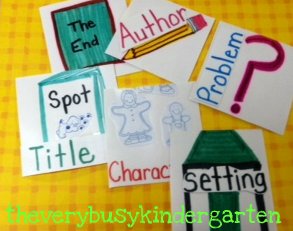In Pictures and In Words Book Study Chapter 7
Hosted By
Illustrators
make many decisions about the “content of an illustration. “ When we take the time to engage our little
ones in discussions and instruction about illustrations they will become
purposeful independent decision makers. That sounds good to me!
Katie
Wood Ray has 11 Techniques in this chapter.
Normally I would just skip by and generalize these but I really feel
each of these are important. So I am
going to type them out for you and for me so I can come back to this and reread
later in the year. The book suggestions
are mine. They are books I know I have
that I can use to teach that technique.
Technique
1 Distance Perspective
Every
illustration has some perspective lead the discussions by talking about zooming
in or zooming away. What is the focal
point?
 |
| I want to share the first page of the story when the egg is very little. |
Technique
2 Positioning Perspective
How
are the objects positioned……are the views from the front, the back, the side,
above, or below.
Have
your little ones talk about the angles that the illustrators want them to see.
 |
| The illustrator shows the owls from many different angels throughout the story. |
Technique
3 The Background
Does
the background have lots of details, no details, or just a little bit? How does the background relate to the central
image?
 |
| The book is great because Harold is drawing the background as the story unfolds. |
 |
| I like this book because the illustrations are beautiful and the trees are gorgeous for each season. Great details. |
The
illustration shows two sides of the same story at the same time.
 |
| This book book is a favorite of mine. The illustrations are beautiful. The story is adorable. The top story is about Granny getting ready for Easter and the bottom story is about the Bunny Family. |
Technique
5 Using Scenes to Show Different Actions
The
illustrator using small separate scenes to show different actions.
Technique
6 Using Scenes to Capture the Passage of
Time
The
illustrator uses scenes to capture what happens over time.
 |
| This book not only deals with the time literally but also size as well. |
Technique
7
Using
Scenes to Show Movement Through Different Places
Technique
8 Small separate scene may work like a
list, showing lots of
different details but unconnected by any background.
 |
| The illustrator has the list of items that the little girl takes with her places and of course her bear. |
Technique
9 Showing, Not Telling
The
text in general but the illustration has a lot more details in it.
 |
| Funny story you will definitely have to help guide the children through the illustrations to discuss the story. |
Technique
10 A Backstory
The
illustrations may have characters or actions that are not mentioned in the
words.
 |
| In this story you have to watch the borders to see that Mattie is making the gingerbread house to catch the gingerbread baby. |
Technique
11 Manipulating Point of View
Adding
humor in the illustration with irony and contradictions.
 |
| I thought of the part when the author write about mouse having to cut his hair........and then there is hair everywhere......even though mouse only had one piece of hair. |































)





